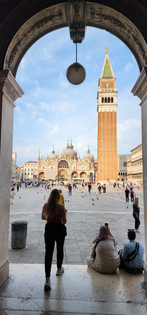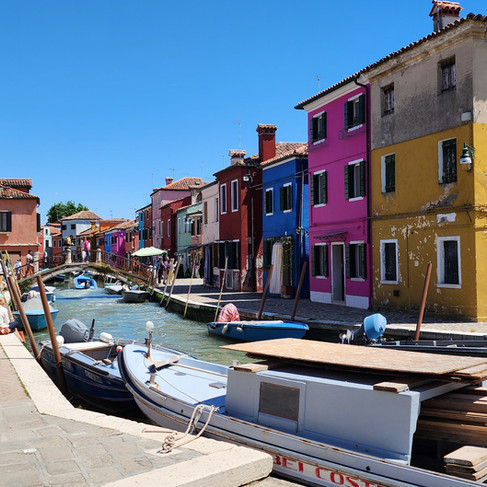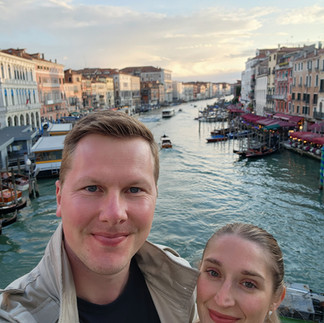Finding Our Rhythm in Venice: Where Ancient Canals Meet Modern Wanderlust
- alexandriazozos
- Jul 1
- 5 min read
Updated: Jul 4
After a whirlwind week of constant movement, Venice greeted us like a deep exhale. Our home base was Hotel Palazzo Paruta (apartment side) with an entrance right off a bustling side street. It was exactly what we needed for space to breathe, a washing machine (pure luxury at this point!), and a front-row seat to Venetian life from our second-floor perch overlooking Campo Sant'Angelo. The square itself is in the San Marco district of Italy and is steeped in history, named after the Church of Sant'Angelo that once stood here until 1837. The asymmetric square is framed by Gothic palaces that once housed wealthy Venetian merchants.
Each evening, we were serenaded by a local guitarist whose classics drifted up through our windows, setting the perfect soundtrack for our Venetian adventure. It felt like we'd stepped into the heart of the city itself.

Venice Proper: A City That Reveals Itself on Foot
Venice isn't large, and that's part of its magic. On our first day, we set out to conquer the major sights, and remarkably, we managed to see most of them, some ideas are below:
St. Mark's Square (Piazza San Marco) - Venice's magnificent central square, surrounded by Byzantine and Gothic architecture including St. Mark's Basilica with its golden mosaics and the iconic Campanile bell tower offering panoramic city views.
Doge's Palace (Palazzo Ducale) - The former residence of Venetian rulers, featuring opulent rooms, Tintoretto masterpieces, and the famous Bridge of Sighs connecting to the old prisons.
Grand Canal - Venice's main waterway best experienced by vaporetto or gondola, lined with stunning palazzos including Ca' Rezzonico, Ca' d'Oro, and the Peggy Guggenheim Collection.
Rialto Bridge and Market - The oldest and most famous bridge spanning the Grand Canal, near the bustling Rialto Market where Venetians have traded goods for over 1,000 years.
Santa Maria della Salute - An impressive Baroque church at the Grand Canal's entrance, built as a votive offering for the city's deliverance from plague.
Peggy Guggenheim Collection - Modern art museum in the former home of the American heiress, featuring works by Picasso, Pollock, and other 20th-century masters along the Grand Canal.
For the foodies out there, Venice offers fantastic Cicchetti tours which highlight small, savory snacks, similar to Spanish tapas, served in Venetian bacari (wine bars) – definitely worth considering if you want a deeper dive into Venetian culinary culture.
If you want to experience a more intimate perspective of the city you simply can’t get on foot, a gondola ride may be for you. Your gondolier will navigate through narrow canals, passing hidden gems and magnificent palazzos with centuries-old skill.
The Islands: Where Venice's True Soul Reveals Itself
While the main island impressed us, it was our second day exploring the outer islands that truly captured our hearts. The 40 minute vaporetto journey took us across the lagoon to discover Venice's quieter side.
The vaporetto stops at several islands, each with its own character. Murano is famous for its centuries of glassmaking tradition, where visitors can watch master artisans shape molten glass into works of art.
Burano was pure poetry – a rainbow of houses lining peaceful canals, each painted in vibrant hues that locals say helped fishermen find their way home through the fog. The island's famous lace-making tradition was evident in shop windows throughout the main street.
Mazzorbo surprised us with its quieter, more agricultural feel. Connected to Burano by a charming footbridge, this island offered a glimpse into lagoon life beyond tourism. It's here that we discovered Venissa, a unique wine resort where we discovered one of our most unique wine tastings from the nearly extinct Dorona grape (revived in 2002). The winemakers prefer a long maceration on the skins, to obtain a white wine with the structure and longevity of a red. With only one hectare of vines producing around 3,500 bottles annually, this ultra-rare wine offers unique flavors of honey, white peach, and briny notes that reflect its salt-influenced lagoon terroir. The wine represents a remarkable revival of Venetian winemaking tradition, combining ancient viticultural methods with the distinctive characteristics of this singular island ecosystem.

Culinary Adventures: From Neighborhood Gems to Signature Dishes
Ristorante Sant'Angelo sat directly beneath our apartment, and it was open with convenient seating and delicious food. As fate would have it, we weren't seated at the front – which proved to be a blessing when a torrential rainstorm hit. The restaurant was brilliantly prepared, with a simple but effective drainage system that drained water right off their awning. We watched the impromptu waterworks while sharing dishes family-style: fresh burrata with tomatoes that tasted like summer, perfectly cooked sea bass, rich spaghetti carbonara, and potatoes so crisp they shattered at first bite. We finished with a creamy dessert topped with tart blueberry compote and fresh mint.
Wine Pairings: For the sea bass, a fun pairing could be Prosecco di Valdobbiadene DOCG from the Veneto hills, whose fine bubbles and crisp acidity provide a refreshing contrast to the delicate fish while cleansing the palate between bites. For the carbonara, a Soave Classico from the Veneto region, whose bright acidity cuts through the rich egg and cheese sauce while maintaining authentic local wine tradition.
On Burano, we had our hearts set on the Trattoria Al Gatto Nero (recommended by good friends), but poor planning meant no day-of reservations. Instead, we discovered Riva Rosa, where we found exactly what we were seeking: risotto di "go" tipico di Burano. This signature dish features a rare fish found only in these specific lagoon waters, creating a risotto unlike any we'd ever tasted. The uniqueness of eating something so geographically specific felt like tasting the essence of the place itself.
Wine Pairing: This delicate, local risotto was perfectly complemented by a crisp Pinot Grigio from Friuli-Venezia Giulia, whose mineral notes echoed the lagoon's salinity.

Our final evening took us to the Canal Grande area, where we joined the parade of tourists crossing the famous bridge for sunset photos (yes, we were absolutely part of that crowd, and no regrets!). Dinner at Riva Rialto along the main stretch gave us front-row seats to the canal's evening theater. Zack chose salmon in a creamy honey mustard sauce with asparagus, while I opted for fresh sea bass with grilled vegetables. We shared crispy potatoes (again) and – embarrassingly for someone whose favorite dessert it is – had our first tiramisu of the entire trip.
Wine Pairings: The honey mustard salmon would have been beautiful with a Gewürztraminer from Alto Adige, while my sea bass is perfect alongside a crisp Vermentino, known for its refreshing acidity and subtle notes of herbs and sea breeze.
Moving Forward
As we finished our laundry, packed our bags, and prepared for our next destination – Bologna, though something tells me there might be an impromptu detour first – Venice left us with something unexpected. It wasn't just the stunning architecture or the romantic canals that captured us. It was the rhythm of the place: the gentle lapping of water against stone, the way wandering the streets became part of the joy.
Venice taught us that sometimes the best travel happens not when you're rushing to see everything, but when you finally slow down enough to actually experience where you are. In a city built on water, we finally learned to go with the flow.
Recommendations: I'd give yourself at least 2 full days in Venice to experience the main island and its surrounding specialities.



































Comments